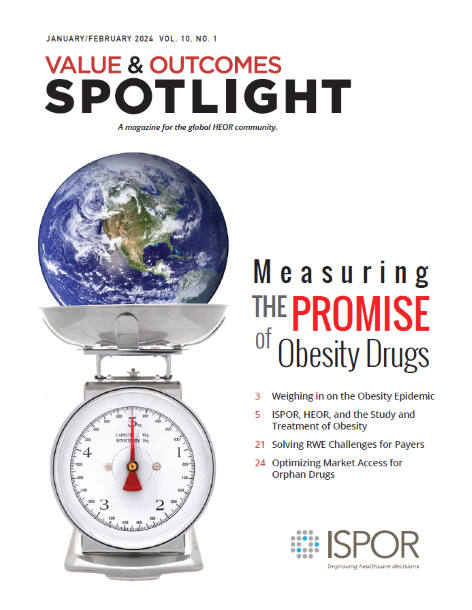Weighing in on the Obesity Epidemic
Zeba M. Khan, RPh, PhD, Editor-in-Chief, Value & Outcomes Spotlight
 Obesity, recognized as a complex health condition, has a long and multifaceted history. In the last century, obesity gained prominence as a global health concern. Industrialization, urbanization, and changes in lifestyle contributed to rising obesity rates. The medicalization of obesity emerged, with researchers exploring its genetic, hormonal, and metabolic aspects. Today, obesity remains a critical public health issue, necessitating comprehensive strategies for prevention and management. According to the World Health Organization (WHO), obesity rates worldwide have nearly tripled since 1975. The United States also faces significant challenges with obesity. In the early 1960s, approximately 13% of the US population was obese according to Centers for Disease Control, but this rose to 41.9% by 2020.
Obesity, recognized as a complex health condition, has a long and multifaceted history. In the last century, obesity gained prominence as a global health concern. Industrialization, urbanization, and changes in lifestyle contributed to rising obesity rates. The medicalization of obesity emerged, with researchers exploring its genetic, hormonal, and metabolic aspects. Today, obesity remains a critical public health issue, necessitating comprehensive strategies for prevention and management. According to the World Health Organization (WHO), obesity rates worldwide have nearly tripled since 1975. The United States also faces significant challenges with obesity. In the early 1960s, approximately 13% of the US population was obese according to Centers for Disease Control, but this rose to 41.9% by 2020.
"According to the WHO, obesity is a major risk factor for heart disease, stroke, high blood pressure, diabetes, musculoskeletal disorders, some cancers, and more."
Obesity is recognized as a chronic disease by organizations like the American Medical Association, which emphasizes its impact on life expectancy and overall well-being. According to the WHO, obesity is a major risk factor for heart disease, stroke, high blood pressure, diabetes, musculoskeletal disorders, some cancers, and more. However, debates persist with disease proponents arguing that obesity meets the criteria for a disease due to its adverse effects on health and associated genetic factors, while opponents view obesity as a preventable risk factor arising from lifestyle choices. Regardless, addressing obesity requires a holistic approach, combining education, policy changes, individual empowerment, and efficacious and safe pharmaceutical options.
Glucagon-like peptide 1 (GLP-1) agonists, originally designed to manage type 2 diabetes and regulate blood sugar levels, have found a new role in obesity treatment and management. These medications mimic the effects of the naturally occurring hormone GLP-1, which responds to food consumption. While several GLP-1 agonists exist, only 2 (Wegovy and Saxenda) have secured approval from the US Food and Drug Administration (FDA) for chronic weight management in individuals who are overweight or obese and do not have type 2 diabetes. Recently, the FDA approved Zepbound for chronic weight management in adults who are obese or overweight with at least 1 weight-related condition such as high blood pressure or type 2 diabetes. Additionally, GLP-1 agonists like Ozempic, initially intended for diabetes treatment, are sometimes prescribed off-label for weight loss. These drugs work by reducing appetite and promoting weight loss, but it’s crucial to remember that their effectiveness hinges on consistent use alongside diet and exercise. Weight regain is likely once the medication is discontinued. However, these pharmaceutical interventions are expensive, costing around $10,000 to $15,000 per year on average in the United States.
The impact of these medications extends across the entire healthcare system, affecting pharmaceutical companies, pharmacies, employers, health plans, and weight-loss companies. By 2035, half of the world’s population could meet the criteria for being overweight or obese, leading to potential costs exceeding $4 trillion annually. In the United States, legislation allowing Medicare Part D coverage for obesity treatment could result in costs ranging from $13.6 billion to $26.8 billion if 10% of beneficiaries use these medications. However, adherence to long-term medications, as well as their safety and potential abuse, remains a challenge, emphasizing the need for comprehensive weight-loss solutions. Additionally, some health plans are scaling back coverage due to their high prices, which can be up to 20 times higher than historical pharmaceutical interventions. Despite the effectiveness of these new treatments, cost remains a concern for stakeholders and patients alike.
"The impact of these medications extends across the entire healthcare system, affecting pharmaceutical companies, pharmacies, employers, health plans, and weight-loss companies."
Reimbursement policies play a pivotal role in ensuring equitable access to obesity treatments for patients who need them. Historically, health insurance coverage for obesity treatment was lacking and patients faced financial barriers, limiting their access to medications. We need more clinical data and real-world evidence. This involves collaboration among healthcare providers, payers, patients, policy makers, and HEOR and clinical researchers as obesity management requires a synchronized effort. This will require a long-term vision beyond immediate savings as we must envision long-term gains. Healthier populations lead to reduced downstream costs. We need to take a holistic approach that would entail reimbursement strategies encompassing lifestyle interventions, medications, and surgical options. No one-size-fits-all solution exists. If we demonstrate improved outcomes and cost-effectiveness, reimbursement barriers will crumble.
As always, I welcome input from our readers. Please feel free to email me at zeba.m.khan@hotmail.com.

